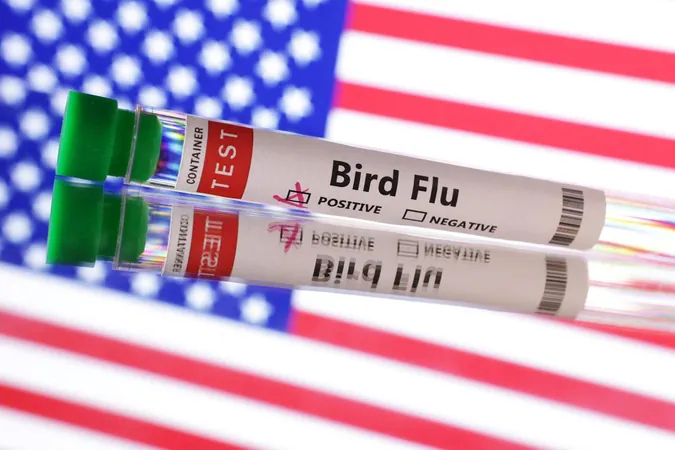
What You Need to Know About Bird Flu After the First US Death
2025-01-07
Author: Li
In the world of influenza viruses, evolution and change are constants.
These viruses are notorious for their ability to mutate continuously, creating new strains that can outsmart immune defenses developed against earlier forms. This perpetual evolution makes influenza a persistent threat not only to humans but also to vulnerable animal populations, particularly birds.
Low Public Risk, High Vigilance
While the Centers for Disease Control and Prevention (CDC) and the World Health Organization (WHO) assert that the risk to the general public remains low, they continue to monitor the situation closely. Their main concern is the potential for human-to-human transmission, a development that could set the stage for a pandemic.
The History of H5N1 and Its Spread
The H5N1 strain was initially identified in 1996 among geese in southern China, rapidly evolving into a global health concern. It has demonstrated a startling capability to migrate across species and continents, resulting in the mass culling of millions of birds by governments to quell outbreaks.
A particularly aggressive variant, classified as clade 2.3.4.4b, emerged in 2020, leading to infections in various mammal species, including minks in Spain and sea lions in Peru. In the United States, this strain has been implicated in dairy cattle infections, primarily affecting individuals who work with sick animals.
Despite these developments, experts like Dr. Michael Osterholm of the Centre for Infectious Disease Research and Policy at the University of Minnesota note that the period from 2017 to 2024 has been the least active in terms of human infections from H5N1 since the virus first emerged.
Emerging Concerns: H5N2 Variant
The H5N2 strain has recently gained attention due to a confirmed human case in Mexico in June 2024, though research on this strain is still limited. The individual who succumbed to the infection had underlying health conditions and no documented exposure to known reservoirs of the virus, raising questions about its transmission potential.
Understanding Bird Flu Risks for Humans
Bird flu poses genuine risks to human health, with 78 confirmed human cases of H5N1 reported worldwide between early 2020 and November 2024, leading to nine fatalities. Interestingly, the severe case in Louisiana marked the first serious infection in the US to be acknowledged by the CDC.
In the wake of recent infections, public health officials are particularly attuned to specific symptoms. Reported cases primarily involve farm workers and are characterized by conjunctivitis, colloquially known as "pink eye," which is a unique indicator since the virus preferentially attaches to receptors present in the eyes.
Effective Treatment Protocols
Prompt treatment for suspected bird flu cases is crucial. The CDC recommends antiviral medications, such as Roche’s Tamiflu, be administered quickly regardless of the illness's severity. This proactive treatment is crucial to curtailing any potential spread.
Vaccination Efforts Underway
While bird flu vaccines are being stockpiled, they are not yet available for general use. The US government has begun producing millions of doses, anticipating future needs should the virus mutate to enhance human transmissibility. Notably, mRNA vaccine technology is also being explored as a rapid-response option against influenza variants.
Impact on US Livestock and Birds
As of early January, approximately 917 herds of cattle across 16 states have tested positive for bird flu, with California declaring a state of emergency. This situation has prompted extensive testing protocols and surveillance efforts to better understand the transmission dynamics of the virus.
Despite significant culling of infected birds, estimates suggest that over 120 million birds have been affected across the country. Farmers are encouraged to divert or destroy affected milk, but the USDA maintains that food safety for pasteurized dairy products remains uncompromised.
Looking Towards Future Risks
Recent studies have indicated that cow udders contain receptors suitable for both avian and human influenza viruses. This discovery raises alarms about the potential for novel strains to emerge, especially in light of a recent positive case of H5N1 in a pig in Oregon, marking a potential change in the landscape of animal-to-human virus transmission.
Public health experts continue to monitor this developing situation closely, remaining vigilant about the potential threats posed by H5N1 and its evolving nature. The situation underscores the importance of ongoing surveillance, swift medical response, and the necessity for innovative vaccine development.




 Brasil (PT)
Brasil (PT)
 Canada (EN)
Canada (EN)
 Chile (ES)
Chile (ES)
 Česko (CS)
Česko (CS)
 대한민국 (KO)
대한민국 (KO)
 España (ES)
España (ES)
 France (FR)
France (FR)
 Hong Kong (EN)
Hong Kong (EN)
 Italia (IT)
Italia (IT)
 日本 (JA)
日本 (JA)
 Magyarország (HU)
Magyarország (HU)
 Norge (NO)
Norge (NO)
 Polska (PL)
Polska (PL)
 Schweiz (DE)
Schweiz (DE)
 Singapore (EN)
Singapore (EN)
 Sverige (SV)
Sverige (SV)
 Suomi (FI)
Suomi (FI)
 Türkiye (TR)
Türkiye (TR)